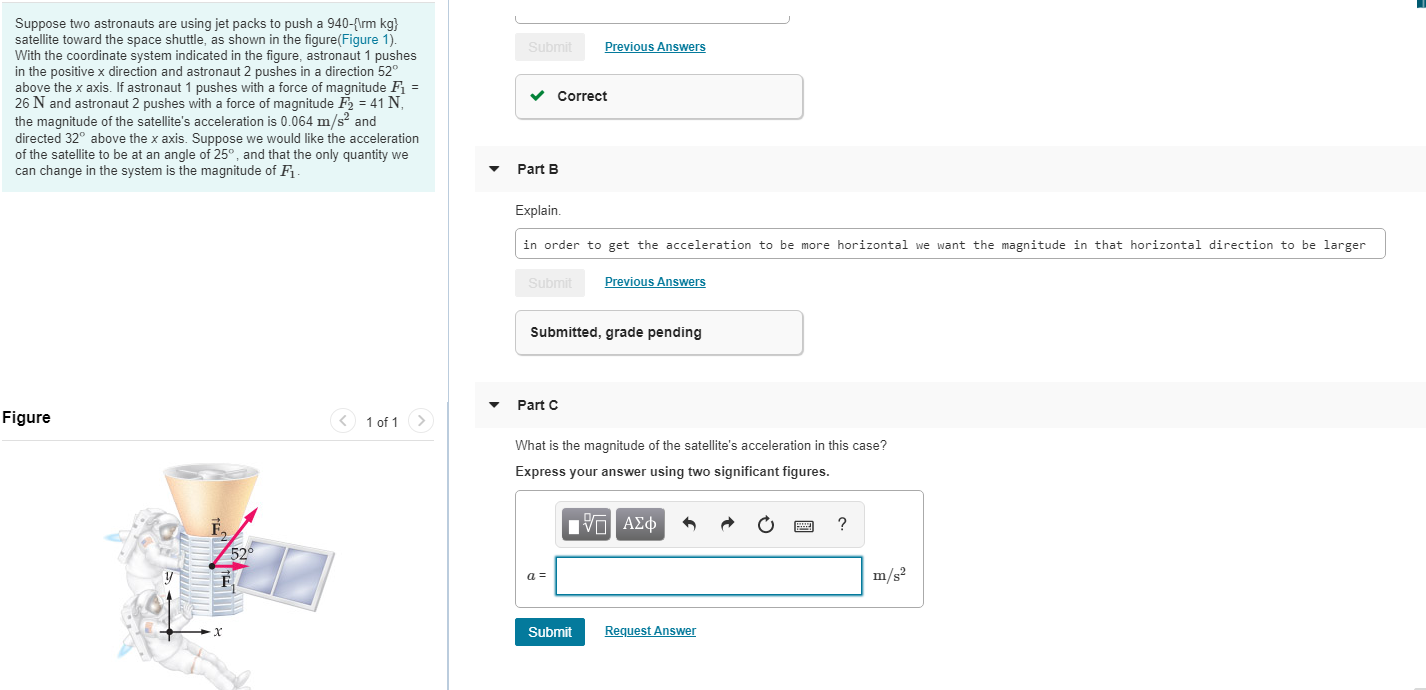Suppose two astronauts are using jet packs to push a 940-{\rm kg} satellite toward the space shuttle, as shown in the figure(Figure 1). With the coordinate system indicated in the figure, astronaut 1 pushes in the positive x direction and astronaut 2 pushes in a direction 52° above the x axis. If astronaut 1 pushes with a force of magnitude F1 = 26 N and astronaut 2 pushes with a force of magnitude F2 = 41 N, the magnitude of the satellite's acceleration is 0.064 m/s? and directed 32° above the x axis. Suppose we would like the acceleration of the satellite to be at an angle of 25°, and that the only quantity we can change in the system is the magnitude of F. Submit Previous Answers Correct Part B Explain. in order to get the acceleration to be more horizontal we want the magnitude in that horizontal direction to be larger Submit Previous Answers Submitted, grade pending Part C Figure < 1 of 1 > What is the magnitude of the satellite's acceleration in this case? Express your answer using two significant figures. Ην ΑΣφ m/s? Submit Request Answer
Suppose two astronauts are using jet packs to push a 940-{\rm kg} satellite toward the space shuttle, as shown in the figure(Figure 1). With the coordinate system indicated in the figure, astronaut 1 pushes in the positive x direction and astronaut 2 pushes in a direction 52° above the x axis. If astronaut 1 pushes with a force of magnitude F1 = 26 N and astronaut 2 pushes with a force of magnitude F2 = 41 N, the magnitude of the satellite's acceleration is 0.064 m/s? and directed 32° above the x axis. Suppose we would like the acceleration of the satellite to be at an angle of 25°, and that the only quantity we can change in the system is the magnitude of F. Submit Previous Answers Correct Part B Explain. in order to get the acceleration to be more horizontal we want the magnitude in that horizontal direction to be larger Submit Previous Answers Submitted, grade pending Part C Figure < 1 of 1 > What is the magnitude of the satellite's acceleration in this case? Express your answer using two significant figures. Ην ΑΣφ m/s? Submit Request Answer
Physics for Scientists and Engineers
10th Edition
ISBN:9781337553278
Author:Raymond A. Serway, John W. Jewett
Publisher:Raymond A. Serway, John W. Jewett
Chapter3: Vectors
Section: Chapter Questions
Problem 15P: The helicopter view in Fig. P3.15 shows two people pulling on a stubborn mule. The person on the...
Related questions
Question

Transcribed Image Text:Suppose two astronauts are using jet packs to push a 940-{\rm kg}
satellite toward the space shuttle, as shown in the figure(Figure 1).
With the coordinate system indicated in the figure, astronaut 1 pushes
in the positive x direction and astronaut 2 pushes in a direction 52°
above the x axis. If astronaut 1 pushes with a force of magnitude F1 =
26 N and astronaut 2 pushes with a force of magnitude F2 = 41 N,
the magnitude of the satellite's acceleration is 0.064 m/s? and
directed 32° above the x axis. Suppose we would like the acceleration
of the satellite to be at an angle of 25°, and that the only quantity we
can change in the system is the magnitude of F.
Submit
Previous Answers
Correct
Part B
Explain.
in order to get the acceleration to be more horizontal we want the magnitude in that horizontal direction to be larger
Submit
Previous Answers
Submitted, grade pending
Part C
Figure
< 1 of 1 >
What is the magnitude of the satellite's acceleration in this case?
Express your answer using two significant figures.
Ην ΑΣφ
m/s?
Submit
Request Answer
Expert Solution
This question has been solved!
Explore an expertly crafted, step-by-step solution for a thorough understanding of key concepts.
This is a popular solution!
Trending now
This is a popular solution!
Step by step
Solved in 3 steps with 3 images

Recommended textbooks for you

Physics for Scientists and Engineers
Physics
ISBN:
9781337553278
Author:
Raymond A. Serway, John W. Jewett
Publisher:
Cengage Learning

Physics for Scientists and Engineers with Modern …
Physics
ISBN:
9781337553292
Author:
Raymond A. Serway, John W. Jewett
Publisher:
Cengage Learning

Principles of Physics: A Calculus-Based Text
Physics
ISBN:
9781133104261
Author:
Raymond A. Serway, John W. Jewett
Publisher:
Cengage Learning

Physics for Scientists and Engineers
Physics
ISBN:
9781337553278
Author:
Raymond A. Serway, John W. Jewett
Publisher:
Cengage Learning

Physics for Scientists and Engineers with Modern …
Physics
ISBN:
9781337553292
Author:
Raymond A. Serway, John W. Jewett
Publisher:
Cengage Learning

Principles of Physics: A Calculus-Based Text
Physics
ISBN:
9781133104261
Author:
Raymond A. Serway, John W. Jewett
Publisher:
Cengage Learning